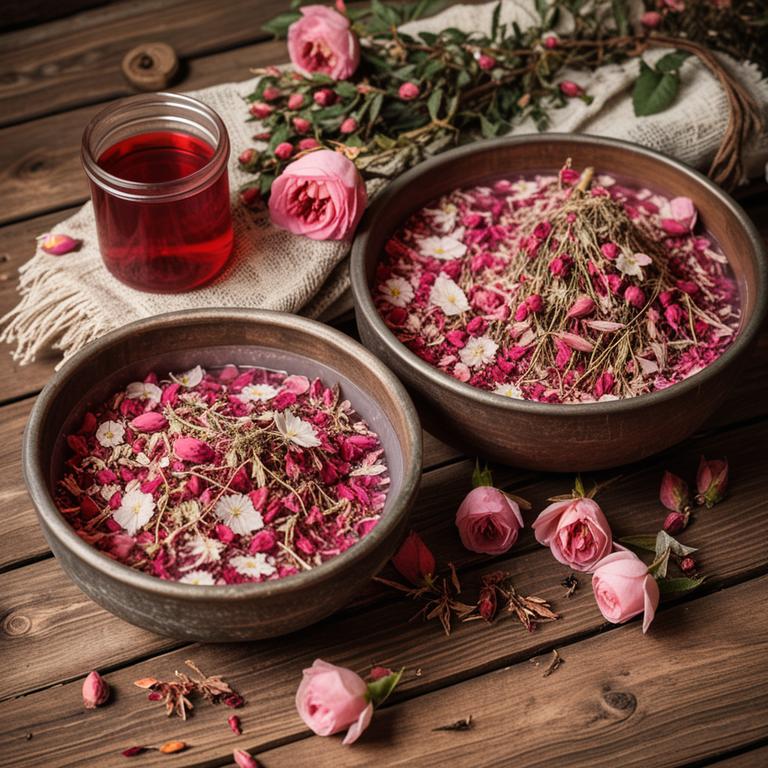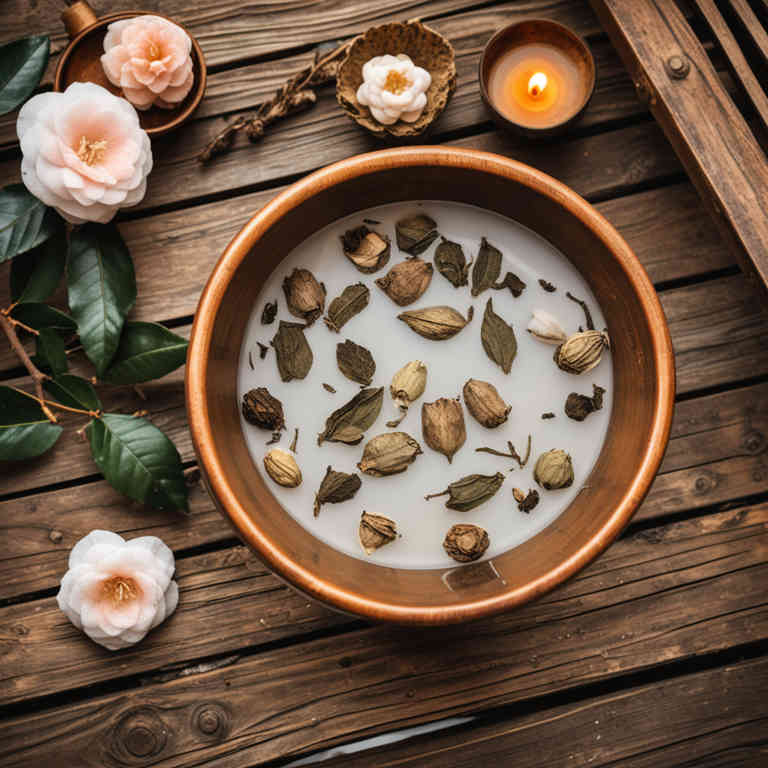10 Best Herbal Baths For Postoperative Recovery

Herbal baths can play a supportive role in postoperative recovery by promoting relaxation and reducing stress, which is essential for healing.
Certain herbs, such as lavender, chamomile, and eucalyptus, are known for their soothing and anti-inflammatory properties that may help alleviate discomfort and inflammation. These baths can also improve circulation and ease muscle tension, contributing to overall physical well-being. However, it is important to consult with a healthcare provider before using herbal baths to ensure they are safe for the specific condition and recovery phase.
When used appropriately, herbal baths can complement traditional medical treatments and enhance the body's natural healing process.
FREE Herb Drying Checklist
How to make sure every batch retains maximum flavor, color, and aroma without the risk of mold or over-drying. Eliminate guesswork and trial-and-error, making herb drying faster, easier, and more efficient every time.
Table of Contents
1. Hypericum perforatum

Hypericum perforatum, commonly known as St. John's Wort, has been traditionally used in herbal baths to support postoperative recovery by promoting relaxation and reducing inflammation.
When infused into warm water, the essential oils and bioactive compounds in hypericum perforatum may help soothe muscle tension and ease pain, aiding in the healing process. These baths can also have a calming effect, which may help reduce stress and anxiety often associated with recovery from surgery. However, it is important to consult with a healthcare provider before using St. John's Wort, as it can interact with certain medications.
Despite its potential benefits, herbal baths should complement, not replace, professional medical care and prescribed treatments.
2. Urtica dioica

Urtica dioica, commonly known as stinging nettle, has been traditionally used in herbal baths to support postoperative recovery due to its anti-inflammatory and astringent properties.
When used in a bath, the leaves can help reduce swelling and promote healing by improving circulation and soothing irritated tissues. The presence of compounds like histamine and formic acid in the plant can provide a mild stimulant effect, which may aid in reducing muscle stiffness and enhancing recovery. However, it is important to dilute the nettle leaves properly to avoid skin irritation, and individuals should consult with a healthcare provider before using it, especially if they have sensitive skin or underlying medical conditions.
Overall, urtica dioica herbal baths can be a complementary therapy to support the body’s natural healing process after surgery.
3. Salvia officinalis

Salvia officinalis, commonly known as sage, has been traditionally used in herbal baths to support postoperative recovery due to its anti-inflammatory and antimicrobial properties.
These baths can help reduce swelling and promote healing by soothing the skin and preventing infections. The essential oils derived from sage leaves can be diluted and added to warm water, creating a therapeutic environment for the body to relax and regenerate. Incorporating sage into postoperative care routines may also aid in reducing stress and improving overall well-being during the recovery period.
However, it is important to consult with a healthcare provider before using sage baths, especially for individuals with sensitive skin or specific medical conditions.
4. Equisetum arvense

Equisetum arvense, commonly known as horsetail, has been traditionally used in herbal baths to support postoperative recovery due to its high concentration of silica and other minerals that promote tissue repair and circulation.
These baths are believed to reduce inflammation and swelling, which are common after surgical procedures, by enhancing the body's natural healing processes. The astringent properties of horsetail may also help in tightening tissues and preventing infection, contributing to faster recovery. When used in warm water, the herbal infusion can soothe sore muscles and joints, providing relief from postoperative discomfort.
However, it is important to consult with a healthcare provider before using horsetail baths, especially for individuals with known allergies or those taking medications that may interact with herbal compounds.
5. Lavandula angustifolia

Lavandula angustifolia, commonly known as English lavender, has been widely used in herbal baths for its soothing and therapeutic properties.
When incorporated into postoperative recovery routines, lavender baths can help reduce inflammation and promote relaxation, which is essential for healing. The calming aroma of lavender has been shown to alleviate stress and anxiety, which can indirectly support the body's natural recovery processes. These baths also provide a gentle form of hydrotherapy that can ease muscle tension and improve circulation around the surgical site.
Overall, lavender herbal baths offer a natural, aromatherapeutic approach that complements medical treatments during the postoperative recovery phase.
6. Achillea millefolium

Achillea millefolium, commonly known as yarrow, has been traditionally used in herbal baths to support postoperative recovery due to its anti-inflammatory and astringent properties.
When infused into bath water, yarrow can help reduce swelling and promote skin healing, which is particularly beneficial after surgical procedures. The soothing effects of yarrow may also aid in relieving discomfort and reducing the risk of infection by creating a clean, antimicrobial environment. However, it is important to consult with a healthcare provider before using yarrow baths, especially for individuals with allergies or those taking medications that may interact with herbal remedies.
Incorporating yarrow into a postoperative care routine can be a natural complement to conventional treatments, enhancing overall recovery and comfort.
7. Rosa canina

Rosa canina, also known as rosehip, is a traditional herbal remedy that has gained attention for its potential benefits in postoperative recovery.
The oil extracted from rosehips is rich in essential fatty acids, vitamins, and antioxidants, which can support tissue repair and reduce inflammation. When used in herbal baths, rosa canina can help soothe sore muscles and promote circulation, aiding in the recovery process after surgery. These baths are often recommended for their calming effects, which can help reduce stress and improve overall well-being during rehabilitation.
Incorporating rosa canina into a postoperative care routine may offer a natural and complementary approach to healing and comfort.
8. Paeonia suffruticosa

Paeonia suffruticosa, commonly known as tree peony, has been traditionally used in herbal baths to support postoperative recovery due to its anti-inflammatory and analgesic properties.
These baths can help reduce swelling, alleviate pain, and promote faster healing by improving local circulation and soothing the skin. The essential oils and extracts from the plant contain compounds that may aid in tissue regeneration and reduce the risk of infection. Incorporating paeonia suffruticosa into postoperative care routines can provide a natural, complementary approach to conventional treatments.
However, it is important to consult with a healthcare provider before using any herbal remedies to ensure safety and effectiveness.
9. Rosmarinus officinalis

Rosmarinus officinalis, commonly known as rosemary, has been traditionally used in herbal baths to support postoperative recovery due to its anti-inflammatory and analgesic properties.
These baths can help reduce swelling and discomfort in surgical areas by promoting circulation and easing muscle tension. The aromatic compounds in rosemary essential oil also have a calming effect, which may aid in reducing stress and improving overall mood during the recovery period. When incorporated into warm water baths, rosemary can provide a soothing and therapeutic experience that complements medical treatments.
However, it is important to consult with a healthcare provider before using rosemary baths, especially for individuals with sensitive skin or specific medical conditions.
10. Camellia sinensis

Camellia sinensis, commonly known as the plant from which green and black teas are derived, has been explored for its potential benefits in postoperative recovery through the use of herbal baths.
These baths, infused with extracts or dried leaves of Camellia sinensis, may promote relaxation and reduce inflammation due to the presence of antioxidants and anti-inflammatory compounds such as catechins and polyphenols. The soothing properties of these baths can help alleviate muscle tension and enhance overall comfort during the recovery period. Additionally, the mild warmth of the bath can improve circulation, which may aid in the healing process and reduce swelling.
While more research is needed, preliminary studies suggest that Camellia sinensis herbal baths could be a complementary therapy to support postoperative wellness.